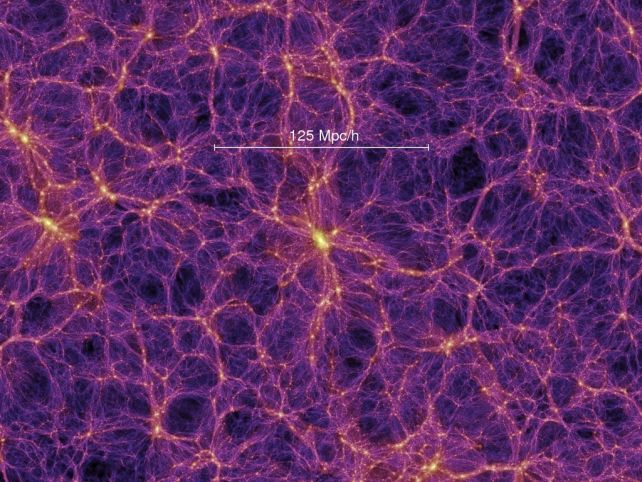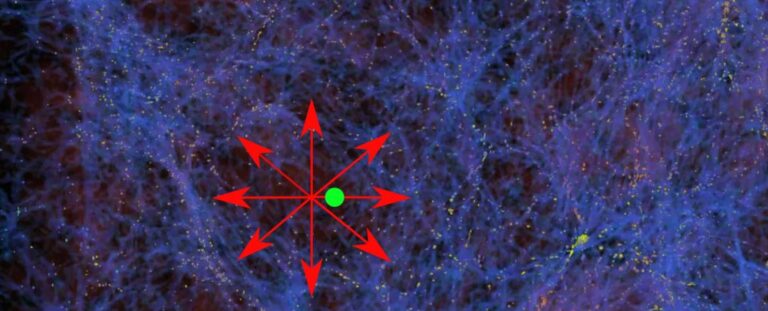Earth Could Reside Within a Vast ‘Supervoid’ in the Cosmos
When we cast our eyes upon the vast expanse of the universe beyond the boundaries of our own Milky Way, we are met with an abundance of celestial wonders. Space is brimming with galaxies, scattered across the darkness like shimmering stars. If we were to stop at this observation, it would be tempting to assume that the distribution of galaxies is relatively uniform throughout the fabric of space and time.
However, there is a discernible pattern amidst this apparent chaos: galaxies have a tendency to congregate into clusters, groups, and elongated structures known as filaments within the cosmic web. They are drawn together by the force of gravity, forming intricate networks of matter highways, superhighways, and nodes.
Conversely, there are also vast expanses known as voids – regions characterized by significantly lower density, where galaxies are relatively scarce.
An increasing body of evidence suggests that our very own Milky Way galaxy resides on the outskirts of one such void within its own little corner of the Universe. This void, aptly named the Local Void, is akin to a bubble of space where the density of matter is notably diminished.

Previous measurements have estimated the size of the void to be approximately 60 megaparsecs, equivalent to around 200 million light-years. However, this is only a partial understanding of the situation.
There is a much larger underdensity called the Local Hole, or Keenan-Barger-Cowie (KBC) supervoid, which spans about 600 megaparsecs. This supervoid poses a significant challenge because, according to the standard model of cosmology, matter should be evenly distributed throughout the Universe.The standard model fails to explain such a vast underdensity.
Nevertheless, a recent study led by astrophysicist Sergij Mazurenko from the University of Bonn suggests that the Local Hole might offer a solution to the Hubble Tension. This tension arises from the inability to reconcile different measurements of the Universe’s expansion speed.The key lies in finding an alternative approach that circumvents the limitations of the standard model.
The rate at which the Universe expands, known as the Hubble Constant or H0, remains uncertain due to varying measurement techniques yielding different outcomes.
There are multiple ways to study the expansion of the Universe. One approach involves examining remnants from the early Universe, such as the cosmic microwave background or frozen acoustic waves. By analyzing these, we can determine a rate of expansion of approximately 67 kilometers (42 miles) per second per megaparsec.
Another method involves measuring the distances to more recent and closer objects with known brightness, like Type Ia supernovae or Cepheid variable stars. This approach yields a rate of expansion around 73 kilometers per second per megaparsec.
Astrophysicist Pavel Kroupa from the University of Bonn explains that the Universe seems to be expanding faster in our vicinity, up to a distance of about three billion light years, than it does as a whole. This observation raises questions as it goes against our expectations.
However, researchers have discovered that considering the Local Hole can help resolve this issue. The concentrations of matter around the edges of the supervoid may locally accelerate galaxies moving away from us in our local space due to gravitational attraction.
This concept is similar to a 2020 study that proposed the Local Void has a similar effect but on a much larger scale.
Nevertheless, the challenge lies in reconciling these findings with the standard model. One potential solution is to adopt a different model for gravity, known as Modified Newtonian Dynamics (MOND). MOND was proposed four decades ago as an alternative explanation to the dark matter theory, which was developed to address inconsistencies in our understanding of gravity in the Universe.
Kroupa states that the standard model is based on Albert Einstein’s theory of gravity. However, it is possible that gravitational forces may behave differently than what Einstein anticipated. The concept of MOND suggests that resolving the Local Hole becomes much easier.
It is important to note that MOND also has its own significant challenges. Nevertheless, it is worth utilizing MOND as a tool to identify gaps in our current understanding of the Universe. Perhaps the true answer lies in a combination of both theories, where Einstein’s ideas can be expanded upon rather than discarded.
Physicist Indranil Banik from St Andrews University suggests that Einstein once said that we cannot solve problems using the same thinking that caused the problems in the first place. This implies that even if the necessary changes are not drastic, we may be witnessing reliable evidence for the need to revise our theory of gravity for the first time in over a century. The research on this topic has been published in the Monthly Notices of the Royal Astronomical Society.
This article is republished from sciencealert under a Creative Commons license. Read the original article.
Do not forget to share your opinion with us to provide you with the best posts !




0 Comments